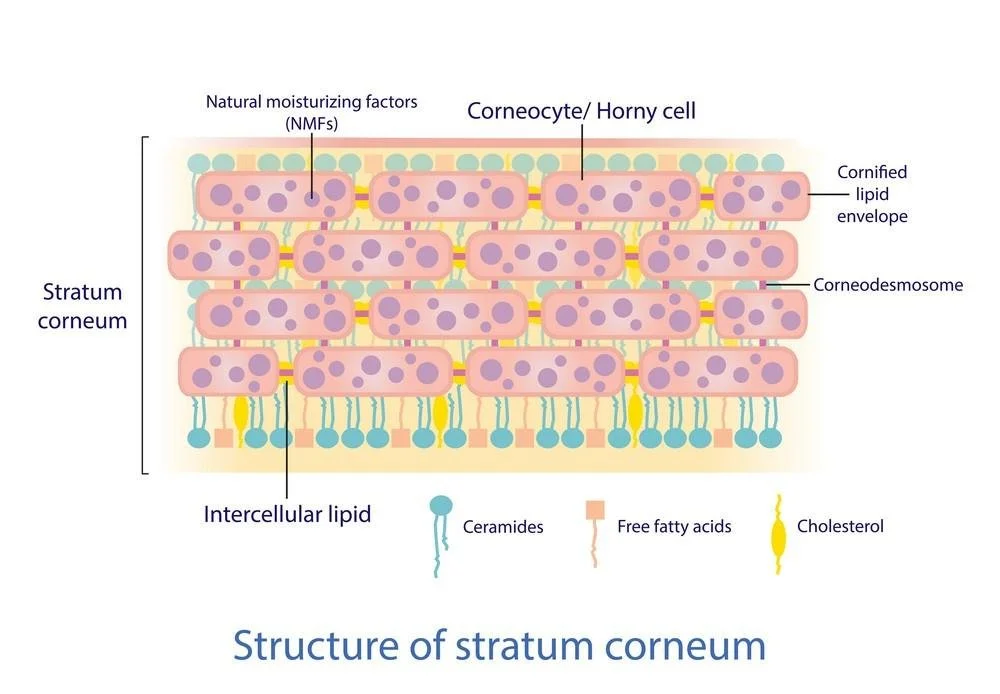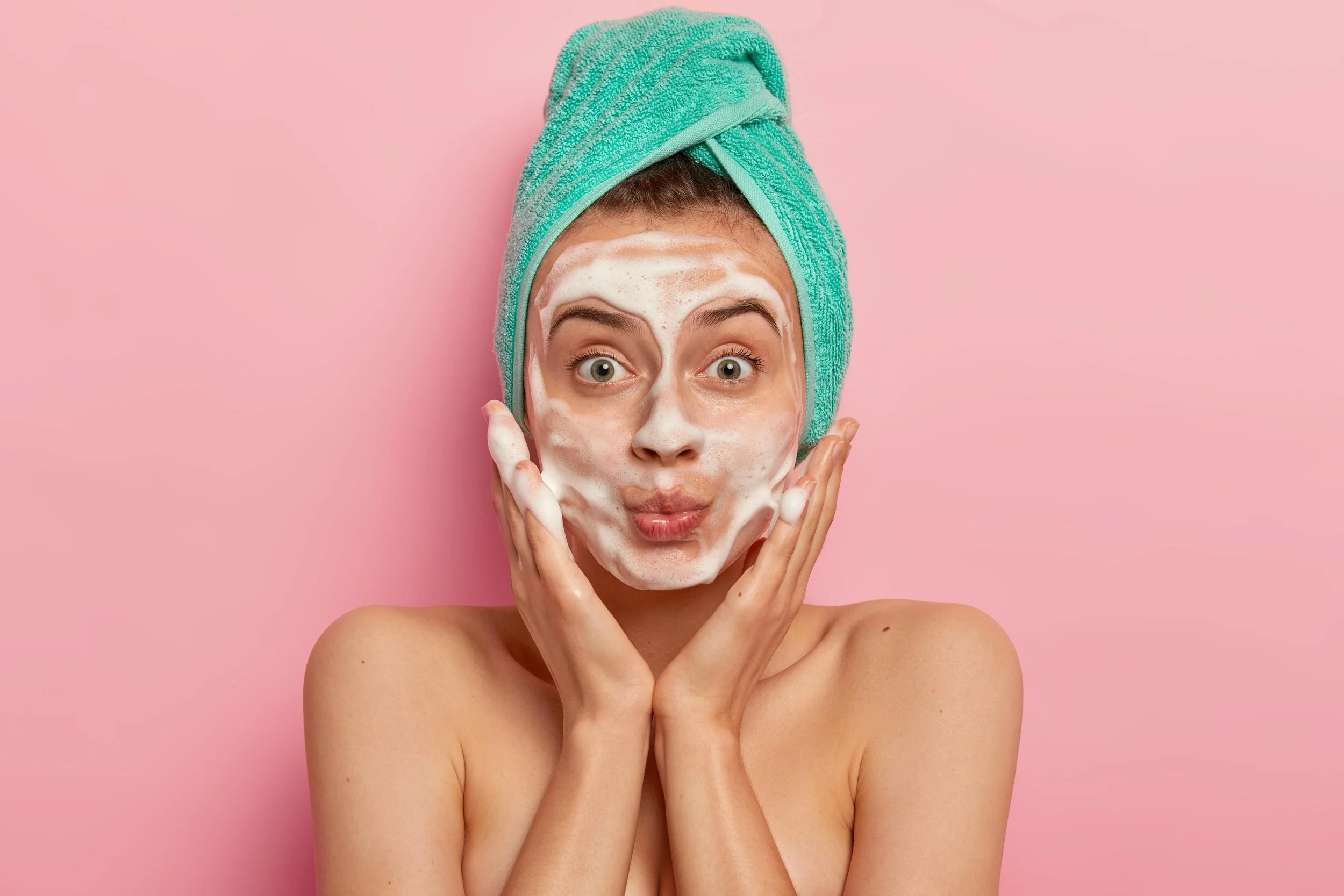🧪 What Your Skin Barrier Is and How to Fix It (Based on Research, Not TikTok)
Disclosure: This post contains affiliate links. As an Amazon Associate, I earn from qualifying purchases—at no extra cost to you. I only recommend products I truly believe in.
Your Skin Barrier Called. It’s Tired.
If your face has been feeling like a crispy tortilla lately—tight, red, flaky, or suddenly freaking out over your favorite serum—there’s a good chance your skin barrier is mad at you. And no, it’s not being dramatic.
Your skin barrier is the unsung hero of your face. It’s the microscopic bouncer that decides who gets in (like hydration) and who stays out (like irritants, pollution, and that one moisturizer that betrayed you). When it’s strong, your skin is soft, calm, and glowy. When it’s compromised? Cue the chaos: dryness, breakouts, burning, redness… basically your skin’s version of a meltdown.
This post isn’t a TikTok trend roundup or a vague “just hydrate!” pep talk. We’re diving deep into what your skin barrier actually is, how it works on a molecular level (yes, science is sexy), what breaks it down, and—most importantly—how to fix it with ingredients backed by peer-reviewed research. Whether you’re a barrier-barbarian or just barrier-curious, I got you.
🧬 What Is the Skin Barrier, Anyway?
Let’s clear something up: your skin barrier isn’t just some vague wellness buzzword. It’s a real, tangible structure—also known as the stratum corneum—and it’s the outermost layer of your skin. Think of it as your skin’s personal bouncer and bodyguard rolled into one.
Biochemically, it’s made up of corneocytes (dead skin cells) packed into a matrix of lipids like ceramides, cholesterol, and fatty acids.
🧱 Picture this: your skin barrier is a brick wall.
Bricks = the corneocytes
Mortar = the lipids holding them together
When the mortar starts to crumble? Water leaks out, irritants sneak in, and suddenly your skin is throwing a tantrum.
So, what does it actually do ?
Blocks environmental aggressors (pollution, microbes, allergens)
Prevents transepidermal water loss —aka your glow escaping
Maintains a smooth, hydrated, resilient surface
Keeps your skincare from turning into a chemistry experiment gone wrong
💡 Bonus nerd point: Your skin barrier is naturally acidic (pH ~4.5–5.5), which helps keep your microbiome happy and hostile to bad bacteria. Disrupt that pH—say, with a harsh cleanser—and the whole system can spiral.
Bottom line: This isn’t just a passive layer. Your skin barrier is a dynamic, biochemical shield that needs maintenance, not marketing fluff. And yep, the science backs it up (Elias, 2005; Proksch et al., 2008).
😬 Signs Your Skin Barrier Is Damaged
Let’s play a quick game:
Is your face...
Suddenly red, itchy, or stinging after applying skincare?
Flaking, peeling, or randomly breaking out?
Feeling tight, dry, or like it’s one sneeze away from cracking?
Acting offended by products that used to be totally chill?
If yes, your skin barrier might be in the middle of a quiet little meltdown.
When your barrier is damaged, the outermost layer of skin—the stratum corneum—starts losing its grip. Moisture escapes. Irritants sneak in. Cue the chaos.
🧪 What causes it?
Over-exfoliating (put down the scrub...)
Harsh, high-pH cleansers
Too many actives at once (retinol + AHA + vitamin C = 🧨)
Sun damage, cold weather, pollution
Even psychological stress (yep, your skin has feelings too)
📈 What happens next?
Transepidermal water loss increases
Inflammation ramps up
Skin feels raw, reactive, and all-around cranky
(Denda et al., 2000)
Bottom line? If your skin is flipping out over everything and feels worse with every new product—pause. Your barrier might just need a reset.
🚫 Common Myths About Barrier Damage
Time to bust a few myths—because your skin barrier deserves better than bad advice from your cousin’s TikTok.
🙄 “It’s just dry skin.”
Not always. Dryness is a symptom, not the root cause. If your skin feels tight and reactive, your barrier’s likely the real issue.
🧼 “Scrub it off!”
Absolutely not. Over-scrubbing makes things worse. You can’t exfoliate your way to a healthy barrier—you’ll just rub it raw.
🔥 “If it tingles, it’s working.”
Nope. Tingling = irritation. And when your barrier’s damaged, that stingy serum is just salt in the wound.
💧 “You just need more hyaluronic acid.”
HA is great, but without lipids to lock it in, you’re just hydrating... and then leaking it right back out. (Science says: pair it with ceramides, or it’s like pouring water into a cracked vase.)
Bottom line? Not all dryness is dry skin. And not all skincare advice is worth following—especially when your barrier’s on the brink.
🔬 The Science of How a Damaged Barrier Happens
Alright, nerd goggles on—here’s what’s really happening when your skin barrier goes from strong and supple to stressed and crispy.
🧱 Step 1: Lipid Disruption
Your skin barrier relies on a precise ratio of ceramides, cholesterol, and fatty acids to hold it together. When that balance gets thrown off—say, by over-cleansing or a harsh exfoliant—the “mortar” starts to crack.
→ Result: Your skin leaks moisture like a broken dam, and irritants sneak in.
Elias, 2005
📉 Step 2: pH Imbalance
Your skin loves to live around pH 4.5–5.5. But many soaps and foaming cleansers have a pH closer to 9 (yikes).
→ This throws off enzyme function, disrupts the microbiome, and weakens the barrier’s structure.
Lambers et al., 2006
☀️ Step 3: External Stressors
Sun exposure, cold weather, air pollution, and even blue light can mess with your barrier on a cellular level. These stressors degrade the lipids and proteins your skin relies on to stay strong and smooth.
→ Over time, this breaks down the very lipids and proteins that keep your barrier intact—making your skin drier, rougher, and more reactive.
D’Orazio et al., 2013
😩 Step 4: Inflammation and Feedback Loops
Once the barrier is compromised, your skin becomes more sensitive—and inflammation ramps up. This triggers even more damage in a vicious cycle.
→ Cue the redness, flaking, stinging, and “Why does everything burn now?” spiral.
Proksch et al., 2008
So, the next time your skin freaks out after a cleanse-mask-exfoliate-retinol marathon, know that it’s not just moody—it’s molecular.
🧴 How to Fix a Damaged Skin Barrier (This Is Where the Fun Begins)
Your skin barrier is like that one overachiever friend: always working overtime, but one burnout away from collapse. Good news? With the right support, it bounces back fast.
Here’s how to give it what it needs—no guesswork, no gimmicks.
1. Use a Gentle, pH-Balanced Cleanser
- Why it works: Your skin’s natural pH is slightly acidic (around 4.5–5.5). High-pH cleansers can disrupt this, making your barrier more vulnerable.
- Look for: Sulfate-free, fragrance-free, pH-balanced
Product Picks:
- CeraVe Hydrating Cleanser — A gentle, non-foaming cleanser with ceramides and hyaluronic acid for dry or sensitive skin.
👉 Check price on Amazon - Vanicream Gentle Facial Cleanser — Minimalist, fragrance-free, and perfect for sensitive or reactive skin types.
👉 Check price on Amazon
2. Rebuild With Ceramides, Cholesterol & Fatty Acids
- Why it works: These are the core “mortar” of your skin barrier. Products with all three help restore the ideal lipid ratio and repair micro-cracks.
Product Picks:
- CeraVe Moisturizing Cream — Rich, fragrance-free cream packed with ceramides and perfect for barrier repair.
👉 Check price on Amazon - Paula’s Choice Barrier Repair Moisturizer — Lightweight but lipid-rich, designed to replenish stressed, sensitive skin.
👉 Check price on Amazon
3. Add Humectants—But Seal Them In
- Why it works: Humectants pull water into the skin. But without an occlusive to seal it in, you can end up more dehydrated than when you started.
Product Picks:
- The Ordinary Hyaluronic Acid 2% + B5 — A budget-friendly hydrating serum that layers beautifully under moisturizer.
👉 Check price on Amazon - Neutrogena Hydro Boost Gel Cream — Lightweight, oil-free hydration that’s especially great for combo or oily skin.
👉 Check price on Amazon
4. Stop Over-Exfoliating
- Why it works: Exfoliants can be amazing—but when your barrier’s inflamed, it’s time to scale back and rebuild.
Product Picks:
- The Inkey List PHA Toner — A gentle, beginner-friendly acid for smoother skin without the sting.
👉 Check price on Amazon - The Ordinary Lactic Acid 5% — Mild exfoliation with added hydration—great if you’re barrier-rebuilding but still glowy-curious.
👉 Check price on Amazon
5. Wear Sunscreen Every. Single. Day.
- Why it works: UV rays break down the lipids and proteins your barrier needs. Daily sunscreen is non-negotiable.
Product Picks:
- EltaMD UV Clear SPF 46 — Lightweight mineral/chemical hybrid with niacinamide—amazing for sensitive or acne-prone skin.
👉 Check price on Amazon - La Roche-Posay Anthelios Mineral SPF 50 — 100% mineral SPF with a smooth finish and great UVA protection.
👉 Check price on Amazon
🧼 Sample Skin Barrier Repair Routine (AM & PM)
Now that you’ve got the science and the strategy, here’s how to put it all together—no 12-step chaos required.
☀️ Morning
- Gentle Cleanser – Clear away sweat and sleep without stripping your barrier.
Try: CeraVe Hydrating Cleanser - Hydrating Serum – Hyaluronic acid or glycerin-based to plump and prep.
Try: The Ordinary Hyaluronic Acid 2% + B5 - Barrier Cream – Lock in moisture with ceramides and lipids.
Try: CeraVe Moisturizing Cream - Sunscreen (SPF 30+) – All that repair means nothing if you skip SPF.
Try: EltaMD UV Clear SPF 46
🌙 Evening
- Gentle Cleanser – Always cleanse, especially if you wear SPF or makeup.
Try: Vanicream Gentle Facial Cleanser - Barrier Serum – Look for niacinamide or peptides to calm and strengthen overnight.
Try: Paula’s Choice Barrier Repair Moisturizer - Rich Moisturizer – Use a thicker cream to seal in hydration while you sleep.
Try: CeraVe Moisturizing Cream
💡 Pro tip: When in doubt, keep it boring. The quieter your routine, the louder your results.
❌ What Not to Do While Healing Your Skin Barrier
Now that you know what to do, let’s talk about what to absolutely, definitely not do while your barrier is in recovery mode.
🚫 Don’t use physical scrubs
Walnut shells, apricot kernels, sugar—you’re not sanding furniture. Skip the grit.
🚫 Don’t layer five actives at once
If your routine includes retinol, AHAs, BHAs, vitamin C, and benzoyl peroxide... baby no. Now’s the time for simplicity, not a chemical cocktail.
🚫 Don’t skip moisturizer
Even if you’re oily. Especially if you’re oily. Dehydrated skin overproduces oil to compensate—hydration helps everything work better.
🚫 Don’t jump into barrier repair one day, then peel your face off the next
Healing takes consistency. If you're adding exfoliants back in, go slow (once a week max) and monitor your skin's response.
🚫 Don’t rely on fragrance-heavy or essential oil-packed products
Lavender and citrus may smell “natural,” but they’re common irritants. Your skin wants science, not spa vibes.
💡 Golden rule? If it stings, burns, flakes, or leaves you shiny and miserable—it’s probably not helping. Listen to your skin and don’t rush the glow-up.
💬 Final Takeaway: Your Skin Barrier = Your BFF
Your skin barrier might not be sexy, sparkly, or trending—but it’s the unsung hero of healthy skin.
When it’s strong:
Your products work better
Your skin stays calm
And you get that juicy, lit-from-within glow
When it’s compromised?
Everything feels like chaos in a bottle. (And your serum starts acting more like a frenemy.)
The good news?
You can absolutely fix it—with science, not guesswork.
🧴 Ditch the 12-step chaos
🫧 Cleanse gently
💦 Moisturize like it’s your job
⛱ Respect your skin’s limits
☀️ And for the love of peptides, wear your SPF
✨ Want to baby your barrier the right way?
Start with one of the products in this post.
Keep your routine simple.
Stick with it.
Your skin will thank you—with glow.
Want to Dig Deeper?
If over-exfoliation was the trigger, ease back and rebuild with this plan — science-recommended recovery steps.
Once your barrier is happier, you can add gentle brighteners back in; start with these low-irritation options.
Want product picks that won’t fight your barrier work? See the dry-skin ingredients and formulas that actually help.
📚 References
Elias PM. Stratum corneum defensive functions: an integrated view. J Invest Dermatol. 2005;125(2):183–200.
Proksch E, Brandner JM, Jensen JM. The skin: an indispensable barrier. Exp Dermatol. 2008;17(12):1063–72.
Denda M, Tsuchiya T, Elias PM. Exposure to a dry environment enhances epidermal permeability barrier function. J Invest Dermatol. 2000;115(3):538–42.
Lambers H, Piessens S, Bloem A, et al. Natural skin surface pH is on average below 5, which is beneficial for its resident flora. Int J Cosmet Sci. 2006;28(5):359–70.
Elias PM. Therapeutic implications of a barrier-based pathogenesis of atopic dermatitis. Clin Dermatol. 2012;30(3):321–32.
Verdier-Sévrain S, Bonté F, Gilchrest BA. Skin hydration: a review on its molecular mechanisms. J Cosmet Dermatol. 2007;6(2):75–82.
Rawlings AV, Harding CR. Moisturization and skin barrier function. Dermatol Ther. 2004;17 Suppl 1:43–8.
D’Orazio J, Jarrett S, Amaro-Ortiz A, et al. UV radiation and the skin. Int J Mol Sci. 2013;14(6):12222–48.




